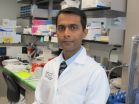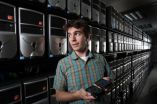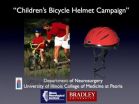(Press-News.org) VIDEO:
This video shows colloidal beads (bright dots) that have assembled themselves on a liquid droplet to form a three-dimensional curved crystalline structure. The positive electric charges cause the beads to...
Click here for more information.
In a paper just published in Nature Materials, a team of researchers that includes William T.M. Irvine, assistant professor in physics at the University of Chicago, has succeeded in creating a defect in the structure of a single-layer crystal by simply inserting an extra particle, and then watching as the crystal "heals" itself. The trick to this self-healing property is that the crystal, an array of microscopic particles, must be curved.
This effect, which carries important implications for improving the conductivity of electronics and other realms of materials science, was predicted six years ago by physicist Mark Bowick of Syracuse University, along with David Nelson, Homin Shin and Alex Travesset, in research supported by the National Science Foundation. NSF also funded the new study.
In order to prove their prediction experimentally, Bowick sought out Paul M. Chaikin of the Center for Soft Matter Research at New York University. Chaikin enlisted the help of Irvine while he was a postdoctoral scientist working in Chaikin's laboratory.
All three researchers specialize in the branch of materials science called "soft matter," which studies a wide range of semi-solid substances such as gels, foams and liquid crystals.
Of soft matter and salad dressing
Bowick described the soft matter microemulsions he works with as being similar to a mayonnaise-based ranch dressing.
"Mayonnaise is made from a mixture of olive oil and vinegar (which is essentially water)," he explained. "You have to beat the ingredients for a long time to disperse tiny droplets of the vinegar in the oil to make an emulsion." But keeping so many droplets mixed evenly throughout the oil requires the presence of a surfactant, a stabilizer that is equally happy in both the oil and the water.
"In ranch dressing, the surfactant used is ground-up mustard seed particles, which arrange themselves at the interface between the water and the oil," Bowick said. "The mustard seed particles collect on the surface of the water droplets."
To study curved crystals, the researchers emulated ranch dressing by adding microscopic acrylic glass particles to an emulsion of glycerol droplets mixed in a base of oil.
Like the mustard seed, the glass particles naturally collect on the surface of individual glycerol droplets. Depending on the experiment, somewhere between 100 and 10,000 particles coat each droplet.
The particles' positive electric charges repel each other, causing them to arrange themselves naturally in a honeycomb pattern, with each particle equally distant from six others.
Scarred crystals
The regular six-sided pattern doesn't fit perfectly around the spherical droplet any more than gift-wrapping a soccer ball results in a perfectly flat paper covering. Just as the paper wrinkles when molding it to the surface of the ball, the curved crystal pattern generates 12 defects, or scars, evenly spaced around the sphere.
The number and location of these scars is a fundamental structural property prescribed by the geometry of the sphere. A similar pattern can be seen on the leather cover of the soccer ball, which requires 12 five-sided pentagons (defects) evenly spaced within an overall six-sided pattern.
Bowick was a member of the team that originally discovered this 12-scar property of curved crystals in 2003. After that, he wondered what would happen if they added an extra particle, called an interstitial, right in the middle of the crystal.
"Even though the particles have self-organized into a crystal pattern, they are still free to wiggle about within that structure," Bowick said. "You'd expect that an additional particle would just push the other ones apart slightly and settle in place, as it would on a flat surface."
The result would be a defective pattern containing an area of seven- and five-sided shapes, rather than the regular six-sided hexagons. But what Bowick and colleagues predicted using computer models is that on a curved surface, an extra particle added halfway between two scars would create a defect in the pattern that splits into two parts.
They calculated that the strain on the crystalline structure caused by these two defects would "flow" away from site, like ripples on a pond, as the particles readjust their distances from one another. Eventually the defects would migrate to opposite scars, where they would disappear.
VIDEO:
This video shows the hexagonal crystal pattern that naturally occurs when the crystalline structure is formed. The regular six-sided pattern imperfectly fits around the spherical droplet, so defects appear. Inserting...
Click here for more information.
Amazingly, the scientists predicted that the original particle's mass would remain close to where it was placed, and large areas of the hexagonal pattern would have rotated slightly ¬— about 30 degrees. But the original defect would be gone.
To prove this remarkable result experimentally, however, required a special instrument.
Making it work
"William Irvine had already begun his beautiful experiments in my lab on colloidal crystals on curved surfaces," recalled NYU's Chaikin. "The present study came from a conversation that Mark Bowick and I had on a plane coming back from a meeting several years ago. Mark's experiment was a natural extension of William's work."
"For this project, we had to figure out how to add a particle to the curved crystal, while imaging the particles as they shift around in three-dimensional space," explained Irvine, who is now at UChicago's James Franck Institute. "This makes the experiment considerably more complicated."
Irvine planned to use optical tweezers to grab a microscopic particle from the surrounding emulsion and place it on the surface of a droplet using radiation pressure from a focused laser beam.
"In most experiments, you come in with the laser 'tweezers' using the same lens as you use for imaging the particle, and that's great, because you want to focus the beam on the same plane where you're looking," Irvine said.
But for this experiment, the laser tweezers and the microscope had to be separated.
"A confocal microscope selects a very thin slice of the object to be imaged, so that one slice is in focus and the rest of the image (before and after) is out of focus, like a photo of a person with their face in focus and the background blurred," he explained. "In order to create a full three-dimensional image, you move the objective up and down and bring the different slices into focus one at a time."
But moving the lens also moves the laser beam holding the particle.
"In order to hold onto a particle and watch what happens as you gradually bring it to the surface of the droplet, you have to essentially build a second microscope on top of the first one," Irvine said. "Technically, that's not trivial — you have to get a lot of things to work at the same time."
But once Irvine had designed and built the instrument, the team tested Bowick's predictions and actually created video images showing the defects moving across the crystal surface and disappearing into the scars.
Self-healing graphene
"The study of crystals on curved surfaces is interesting and important for systems that range from geodesic domes to viruses to Buckyballs," said Chaikin, referring to symmetric molecules of carbon. "The defect structure and the 'healing' of defects are particularly important in the conductivity, heat and mechanical properties of carbon nanotubes, graphene and similar materials."
Graphene, a two-dimensional sheet of carbon molecules, is a very strong material and a good conductor of electricity.
"There are always going to be defects that will decrease the conductivity of graphene," said Bowick. "Ultimately, for electronic devices, you want graphene with high conductivity and as pure as possible."
And that's where the researchers' discovery could prove an ideal solution. "You might be able to simply flex a piece of graphene, remove the defects, and improve the conductivity," Bowick said.
###
— Adapted from a National Science Foundation news release.
Citation: "Fractionalization of interstitials in curved colloidal crystals," by William T.M. Irvine, Mark J. Bowick and Paul M. Chaikin, Nature Materials, published online Sept. 30, 2012.
Funding: National Science Foundation grants DMR-0808812, DMR-0820341, DMR-1105417 and DMR-0820054
Scientists discover novel way to remove defects in materials
2012-10-02
ELSE PRESS RELEASES FROM THIS DATE:
New hope for taming triple-negative breast cancer
2012-10-02
SAN ANTONIO (Oct. 1, 2012) — Disease-free survival is short-lived for women with triple-negative breast cancer — a form of the disease that doesn't respond to hormone drugs and becomes resistant to chemotherapy. Thankfully, a promising line of study in the School of Medicine at The University of Texas Health Science Center San Antonio suggests it is possible to fine-tune the properties of this fearsome cancer, making it more sensitive to treatment.
Once preclinical studies have been completed in coming months, this new approach should be ready to test in female patients, ...
UCLA-led study finds direct correlation between hospital bedsores, patient mortality
2012-10-02
A new clinical study spearheaded by the dean of UCLA's School of Nursing has found a direct correlation between pressure ulcers — commonly known as bedsores — and patient mortality and increased hospitalization.
The research is believed to be the first of its kind to use data directly from medical records to assess the impact of hospital-acquired pressure ulcers on Medicare patients at national and state levels.
According to the study, featured as the lead article in the current issue of the Journal of the American Geriatrics Society, seniors who developed pressure ...
Restoring sight would save global economy $202 billion each year
2012-10-02
Restoring sight would save global economy US$202 billion each year.
Governments could add billions of dollars to their economies annually by funding the provision of an eye examination and a pair of glasses to the estimated 703 million people globally that needed them in 2010 according to a new study to be released soon.
The health economics study calculated that there would be a saving of US$202 billion annually to the global economy through a one-off investment of US$28 billion in human resource development and establishing and providing vision care for 5 years.1 ...
Sandia builds Android-based network to study cyber disruptions
2012-10-02
LIVERMORE, Calif. — As part of ongoing research to help prevent and mitigate disruptions to computer networks on the Internet, researchers at Sandia National Laboratories in California have turned their attention to smartphones and other hand-held computing devices.
Sandia cyber researchers linked together 300,000 virtual hand-held computing devices running the Android operating system so they can study large networks of smartphones and find ways to make them more reliable and secure. Android dominates the smartphone industry and runs on a range of computing gadgets.
The ...
Concussion spectrum in college athletes wearing helmets: 'Not so simple,' say researchers
2012-10-02
Charlottesville, VA (October 2, 2012). What does it mean to have a head concussion? Much has been written in recent years about the short- and long-term consequences of concussions sustained in sports, combat, and accidents. However, there appear to be no steadfast rules guiding the definition of concussion: the characteristics associated with this type of traumatic head injury have shifted over time and across medical disciplines. Within the context of a larger longitudinal investigation of the biomechanical factors in play that correlate with concussions in collegiate ...
Children's bicycle helmets shown to be effective in impact and crush tests
2012-10-02
Charlottesville, VA (October 2, 2012). A favorite physical activity engaged in by Americans is bicycling, and children are perhaps its most ardent participants; it has been estimated that 70% of children ages 5 to 14 ride bicycles. Bicycling is not without its dangers, however, and one of the worst is the risk of head and brain injury during a crash. According to the US Centers for Disease Control, head injury is the most common cause of death and serious disability from bicycle crashes. The best protection offered to mitigate this injury is the bicycle helmet. However, ...
Does gender affect acute concussive injury in soccer players? 'No' according to this study
2012-10-02
Charlottesville, VA (October 2, 2012). Much has been printed suggesting gender-related differences in athletes' responses to sports-related concussion, including differences in concussion incidence, symptoms reported, and scores on neurocognitive tests before and after injury. Nevertheless, findings have not been unanimous, and no guidelines regarding gender-specific strategies for prevention or treatment of sports-related concussion have been developed. Researchers at Vanderbilt University, the University of Albany, and ImPACT Applications, Inc., set out to review symptoms ...
Study finds no gender-related difference in neurocognitive testing after sports-related concussions
2012-10-02
As female participation in sports grows rapidly, there is a popular notion that there are gender-related differences in athletes' responses to sports-related concussion, and prior research has supported these gender discrepancies.
However, a Vanderbilt University Medical Center study, conducted to review symptoms and neurocognitive findings in male and female high school soccer players, shows no gender-related differences.
"There has been good data that suggests girls score worse on neurocognitive testing following a sports-related concussion. Our hypothesis was that ...
'Superweeds' linked to rising herbicide use in GM crops
2012-10-02
PULLMAN, Wash. -- A study published this week by Washington State University research professor Charles Benbrook finds that the use of herbicides in the production of three genetically modified herbicide-tolerant crops -- cotton, soybeans and corn -- has actually increased. This counterintuitive finding is based on an exhaustive analysis of publicly available data from the U.S. Department of Agriculture's National Agriculture Statistics Service. Benbrook's analysis is the first peer-reviewed, published estimate of the impacts of genetically engineered (GE) herbicide-resistant ...
Work is more fun if the character fits the bill
2012-10-02
Character strengths can be defined as traits that are evaluated as morally positive, such as self-control, teamwork or kindness. Character strengths that are particularly distinctive for a person and which he or she likes to use frequently are referred to as signature strengths. Everybody typically has between three and seven of these signature strengths. For the first time, Claudia Harzer and Professor Willibald Ruch from the Section on Personality and Assessment at the University of Zurich now prove in two studies that a job is particularly cherished if it suits one's ...


